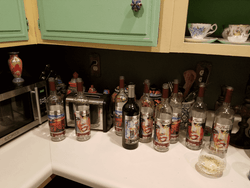Developing your palate as a wine connoisseur takes time. It doesn’t happen overnight. However, once you know what you’re looking for and how to determine if something is good or bad, you’ve got a skill that you can use forever. I’m going to outline my four basic techniques for tasting a glass of wine. I didn’t invent this so don’t give me too much credit. However, it’s an awesome and simple solution to making sure when you go wine tasting you get the most out of each and every sip.
Look at the Wine
 The color and opacity of a wine give you hints about the age in the grape varietal. It can also give you clues into the level of alcohol sugar and even what the climate was during the time the great was actually grown. Yes, the look of the wine has a great deal to do with the wine itself. This is commonly referred to as Wine legs. There are many clues about a wine buried into its appearance.
The color and opacity of a wine give you hints about the age in the grape varietal. It can also give you clues into the level of alcohol sugar and even what the climate was during the time the great was actually grown. Yes, the look of the wine has a great deal to do with the wine itself. This is commonly referred to as Wine legs. There are many clues about a wine buried into its appearance.
As white wines get older they tend to change color and become more yellow, Brown or increase in overall pigmentation. As a red wine begins to age it starts to lose its color become transparent as time goes on.’s are great ways to tell the wine is ready to go or not. You don’t always have to taste the wine to know it’s going to be good or bad.
Furthermore, if you look at the color and the rim variation you’ll be over to pick up a few more things about the wine. For example, a Grenache red wines will have a translucent or orange color on the rim, even in their youth. Additionally, a Pinot Noir wine often has a true ruby red color, especially if it came from a colder climate.
Finally, the alcohol and sugar content of a wine can easily be seen in the wine legs. Wine legs can tell us if the wind has high or low alcohol and it has high or low sugar. The thicker and more viscous the legs are more alcohol or residual sugar is contained in the wine.
So the next time you go wine tasting, lift the glass and swirl it around a bit. As you swirl the wine around in the glass watch for these wine legs. Then pour the wine towards the edge of the glass and see if the color changes towards the end.
Smell the Wine
 The aroma given off by wine gives away a lot about the wine itself. You can determine the great variety, whether or not it was aged in oak her steal, where the wine came from and how old the wine actually is. The train nose or pallet can pick up these details matter of moments. The best way for you to get to know what is what is to experiment. There’s no better way to develop your palate in my smelling different types of wines from different areas across the globe.
The aroma given off by wine gives away a lot about the wine itself. You can determine the great variety, whether or not it was aged in oak her steal, where the wine came from and how old the wine actually is. The train nose or pallet can pick up these details matter of moments. The best way for you to get to know what is what is to experiment. There’s no better way to develop your palate in my smelling different types of wines from different areas across the globe.
A single glass of wine can have hundreds of different compounds in it. This is why people smell so many different things when they attempt to explain the flavors in the aroma. It’s easy to get lost in the language since everyone interprets things in different ways. No one’s really wrong when it comes to the aromas that they pick up in a glass of wine. We pick up these aromas kind of like a scratch and sniff sticker. These aroma compounds are actually called stereoisomers. Wine aromas fall into three basic categories. Primary Aromas, Secondary Aromas, and Tertiary Aromas
The primary aromas come from the type of grape in the climate where it’s grown. Generally speaking, this is the fruit flavor of the wine.
The secondary aromas come from the fermentation process or the yeast.
Finally, the tertiary aromas which are calmly referred to as the bouquet come from the process of aging the wine. aging aromas are treated to oxidation, aging in oak, and in the bottle itself over a period of time. One common example of this is the aroma of the vanilla which is picked up when winds are aged in oak.
Taste the Wine
 Now, this is where the fun begins. I know. You have been waiting for me to get to this part. 🙂 When tasting a wine there are five things that you’re going to be looking for. I’m Going to take a few minutes and try to explain five areas that really bring about the taste of a good glass of wine.
Now, this is where the fun begins. I know. You have been waiting for me to get to this part. 🙂 When tasting a wine there are five things that you’re going to be looking for. I’m Going to take a few minutes and try to explain five areas that really bring about the taste of a good glass of wine.
SWEETNESS: The best way to experience the sweetness of the wine is on the front of your tongue in the first moment you taste the wine.
ACIDITY: The acidity level and wine are based on its pH level. Acidity is how sour the wine might taste. It’s that puckering sensation in the nack of your mouth. High acid wines are often described as tart or tangy. a pH in wine ranges from 2.6, which is very acidic, to about 4.9 which is detectable as tart to a much more neutral 7.0 which is pretty soft. Most wines range between a 3 and a 4 pH level. a wine with a higher acidic level tends to be more tart and mouthwatering. A higher acidity can help you determine if the wind is from a cooler climate region or if the wine grapes were picked early. A lower acid level in a wine tends to taste smoother and creamier with less mouthwatering qualities. A super low acid level will taste flat.
TANNIN: This is a characteristic found in red wine and can tell you the type of grape, if it was aged in oak or not and how long the wind has aged. You only perceive tannins on your palette and only with red wines. It might remind your taste buds of a cotton ball or something else which is drying on your tongue. Tannins come from two different places. It is either from the skins and seeds of the grape or from the oak aging process. If it is coming from the great tenant then it will be typically more abrasive and can taste more green. It was coming from Oak then you find a much smoother and around her feel. It would typically your tongue in the center.
ALCOHOL: The alcohol in a wine can often tell us the intensity of the wine in the rightness of the grape that went into making the wine itself. the level of alcohol in the wine and add quite a bit of body and texture to the wine. Alcohol levels range between 5% ABV and 17% ABV. The alcohol level is a direct correlation to the sweetness of the grapes prior to the firm drinking the wine.
BODY: The body can give clues to the type of wine and region in which it has grown. The body is directly related to the level of alcohol. You want to think of this as how the wine rests on your palate. When you Swishing around your mouth compared to a glass of milk in terms of texture. Does it feel like skim milk or whole milk? If you understand the texture of the wine you’ll better understand the wind itself. the texture of the wine will correspond with white medium and full-bodied this of a wine. This is where it all starts to come together. The “finish” of the wine is the thing you are looking for. This is how your mouth feels 20 seconds after taking a sip.
Sum up what you think of the Wine
– What is the overall profile of the wine that you just tasted?
– Was the wine fruit forward in the nose?
– Was it acid driven at the finish?
– Did you pick up jammy fruits on the tip of your tongue? Was the texture rich and creamy or very thin?
As you start to get familiar with these areas you’ll understand exactly what you like what you don’t like in a wine.
So, pick up a few bottles, store them properly, and start the drinking process.
Cheers!
Jason McClain, Proprietor
McClain Cellars





